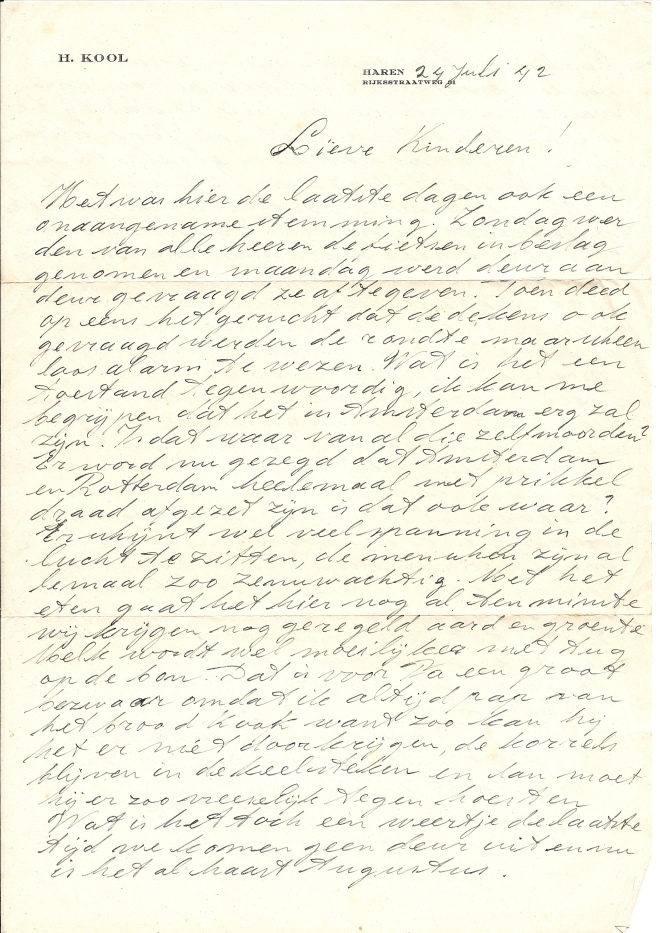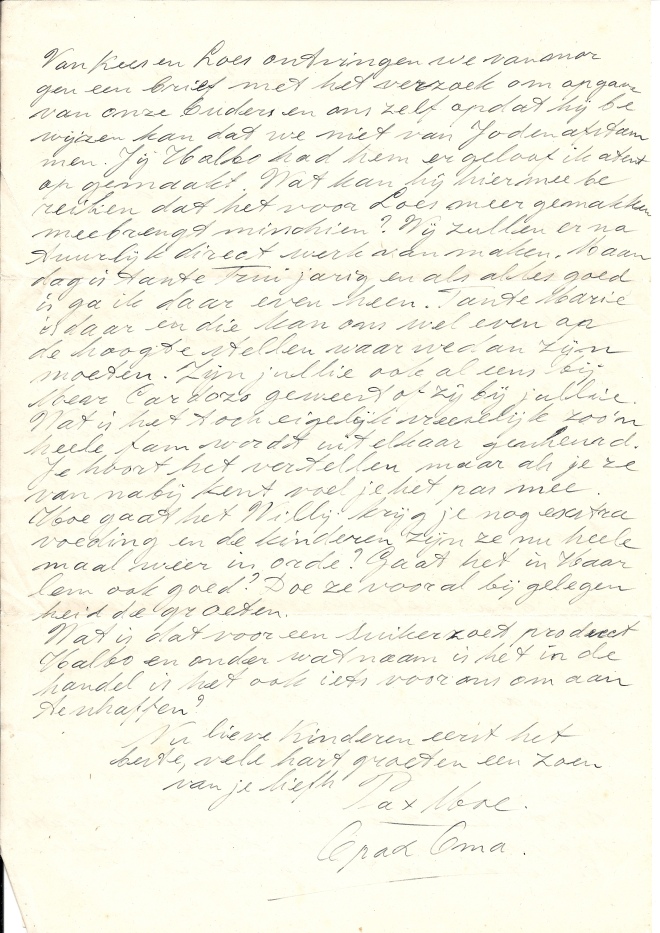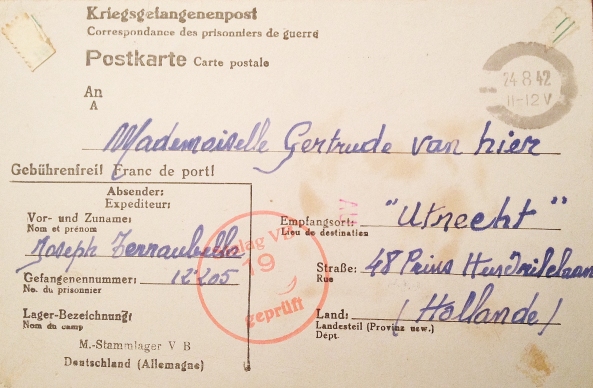
A young Johan Siersema at the foot of Maria Wilhelmina van Erp and Klaas Siersema in this undated photo.
The early years
In his own words, Johan Nico Siersema had a hard life.
Hans, as he was called by family and friends, was born on the 9th of October, 1924, in Venlo, Limberg, Netherlands, and was the first son of Helena “Lenie” de Wit and Klaas “Niek” Siersema.
Hans later had one brother, named Tonny, but Tonny died at the age of 2. After Hans’ parents divorced when he was 5, he was essentially raised by his step-mother, Maria Wilhelmina van Erp, and never really had a good relationship with his birth mother thereafter.

Johan “Hans” Siersema and cousins. Date unknown.
Hans was 13 when he started smoking and drinking, and those became lifelong habits. Later in life, he sometimes smoked from a pipe, but preferred unfiltered cigarettes — Pall Mall — and Scotch.
He attended Gooisch Higher Citizens School in Bussum from 1937 to 1943, when he graduated, according to a Dutch newspaper (De Gooi- en Eemlander : nieuws- en advertentieblad June 5 1943).
During that time, he was a strong competitive breaststroke swimmer, coming in second in a local race in 1941 that was reported by a newspaper. In one tale of family lore, he missed a chance at being in the Olympics because it was cancelled for the war.
He met his future wife and my grandmother, Christina “Tineke” Kool, in wartime during the end of his high school years (he was 17 and she was 14), but I don’t know the story of it.
Hans was very smart — with an 139 I.Q. — but he was waylaid from attending university by the war.
Wartime
During the German occupation, he was a member of the Dutch Resistance and was involved in clandestine operations. Some of these included exerting pressure on Dutch police to set an example as to why it was a bad idea for local police to help the Nazis.
Hans went by at least two aliases: Ferdinand de Wit and Johan de Wit. The way he put it, the Nazis couldn’t really confirm his identity one way or the other. They didn’t have the technology that we do.
At some point during the war, Hans found himself as the only remaining living member of three resistance cells, according to a story Hans told my Uncle Nick. According to the story, each cell had about 20 members and then a person from one cell would have contact with the next so they could coordinate. As the only living member, he was made to go identify the dead bodies of resistance fighters lined up on sand dunes. He managed to identify a couple, but then said he couldn’t do it anymore.
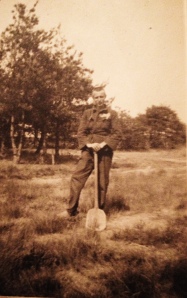
Here, Johan “Hans” Siersema is shown in the POW camp where he was forced to dig up un-detonated bombs dropped from airplanes. Helena de Wit reportedly bribed a guard in order to visit her son and this photo is a product of that visit. In one story, he reached a bomb and it started ticking. He scrambled out of the hole and started running and when a Nazi guard started shouting at him to get back down there, Hans shouted back that the guard ought to run, too.
In 1944, Hans was a prisoner of war and was held in Kamp Amersfort, about 20 miles from Arnhem, Holland. His job as a prisoner was to dig 10-foot deep holes around the perimeter of the camp in search for buried land mines. Consequently, he watched his friends who worked with him be blown up and die, according to what my mom remembers from a conversation with him.
He attempted to escape several times before he was eventually successful in September of 1944. According to an interview he did in the 1980s with my mom, English planes were landing at Arnhem, 20 miles away…
“When that happened, the Germans … let the Red Cross in and the Red Cross insisted that anybody that was sick would be released immediately, so that there would only be healthy people there.”
“…I had a friend who was a medical student who worked for the doctor and he took a blood sample and switched mine with one that had T.B. So I had to leave and they gave me my walking papers and I got out.”
Hans returned to his family then. When the car pulled up to Klaas Siersema’s house to deliver him to his family, Klaas was worried it was the Nazis coming to take him, so he went and hid in a tobacco patch he had grown in the back yard.
When my mom asked Hans what he did between the time of his escape in ’44 and when the war ended in ’45, his response was, “I was hungry.” They were on rations then of two pounds of potatoes and four pounds of sugar beets per week. In the same interview, he talked about his aunt Leentje Siersema and his uncle Leendert Vlaasbloem, who died of starvation just three days apart.
According to a story Hans told emotional and late into the night to Cousin Michael, “Later in the war he said he was in France with his best friend. They were waiting on a British sub to come carry them to the British Isles. They went to a bar and got into a fight. That landed them in a french jail. They we then given to the Nazis by the French and he spent the rest of the war in a prison camp.”
“When the British we coming to liberate the camp, he told me the Nazis decide to kill the prisoners and he stood beside his best friend and fellow freedom fighter as a Nazi shot his friend in the head.”
I am not sure at what point, but on the run from the Nazis either before his capture or after his escape, Hans went to his mother looking for a place to hide. She turned him away for fear of being found out, so the story goes, and their relationship was further damaged.
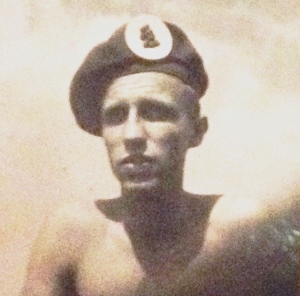
Johan Siersema
Hans enlisted in the Royal Netherlands Army in Eindhoven on the 9th of July, 1945. At that time, the German Occupation had ended, but the war with Japan was still going. He was sent to England, where he was a small arms instructor for the new Dutch Army until 1946, when the military wanted to send him to Indonesia. Hans resigned his commission then, wanting to get away from the fighting, which he’d just done for five years.
In a story Hans later told my Uncle Nick, Hans once found himself guarding Nazi prisoners. One of them spoke up, saying Hans looked familiar. It turned out the Nazi prisoner had guarded Hans before and their roles were reversed.
Later, he was commended to be of good character by the mayor of Doorn, but I am not sure why.
Following wartime, a 23-years-old Hans enrolled in university. Because he felt like he’d lost so much time already, he rarely went to classes. Instead, he studied books and showed up to take exams. He graduated with a degree in economics after two years instead of the typical four.
“You know, I’d lost a number of years,” he explained his motivation.
Between July and September of 1949, he and Tineke eloped in Aylesbury, Buckinghamshire, England.
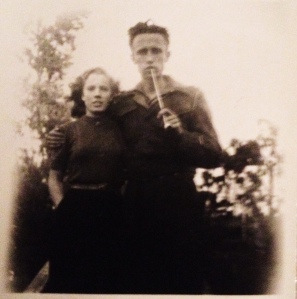
Christina Kool and Johan Siersema in 1945.
“What happened is, we started sleeping together, and in those days, Sweetheart, that wasn’t done — that was not done. But we wanted to keep on sleeping together, so we secretly got married,” he said in the interview with my mom.
They were officially married with family present the following year.
Note: I will continue my grandfather’s story in a second bio post. Here, I tried to be as factual as possible, but if I’ve learned anything looking into my family history, it’s that everyone can have a different story about the same events. I welcome anyone who wants to share their story of Opa John in the comments and I will continually update this post as more information become clear to me. I would love to do a separate post with everyone’s memories. For instance, until recently, I’d forgotten how he made a sort of whistling noise through his teeth when he spoke.


